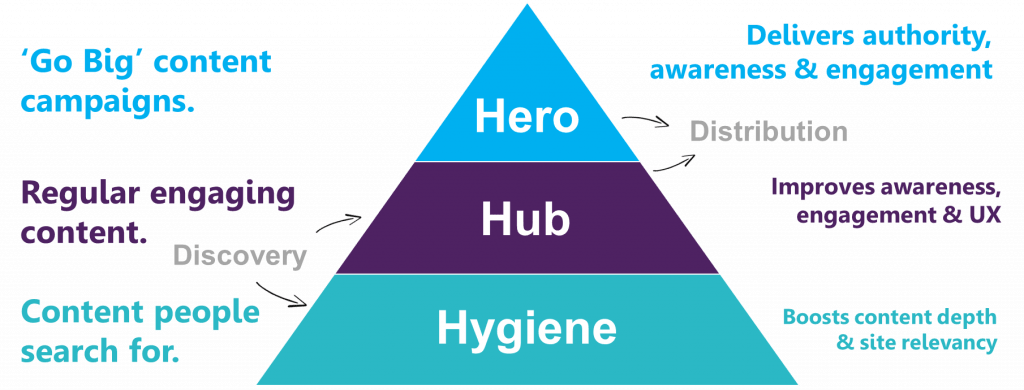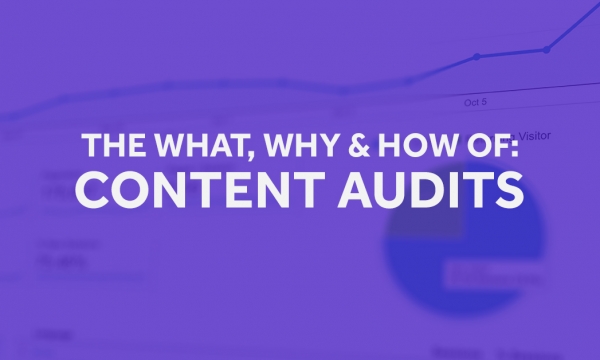The “three H’s” have been discussed for some time in content marketing circles – we even discuss them in our 90 Plan to transform your content marketing strategy. But beyond the theory, what do they actually mean for the practicalities of your content marketing strategy? We break it down, and pinpoint precisely what you should be looking for at each key stage.
What is hero, hub and hygiene?
The ‘Hero, Hub, Hygiene’ model is a content marketing model devised by Google for YouTube publishers, but the principles can be applied to all forms of content marketing.

It’s designed to help publishers and marketers ensure that they can fill the gaps in their content, and to plan their future content strategy. It is also designed to help publishers ensure that their plan addresses the need for both fundamental content, as well as creative brand-building activity.
But first, get your brand proposition right
Before you start, make sure that are clear on what your brand actually has to offer, and the audiences that you are offering it to. This forms the basis of your entire content strategy.
What does your brand bring to the market? What does it offer to consumers? Why does it stand out from the competition? This should be at the heart of your content’s message and tone.
You may find the answer to this in your company mission statement. Is your brand mission to deliver luxury and quality, or is it to deliver value for money?
Those two extremes require very different tones and types of content, and appeal to very different audience demographics, it’s important to understand this proposition, and to pitch your content accordingly.
Cleaning up with hygiene content

Hygiene content isn’t often the sort of content that stands out from the crowd and earns the awards at the fancy annual bash, which is why it often gets overlooked as part of a content marketing strategy. But it undoubtedly the unsung hero of content.
In its simplest form, hygiene content is the functional content that forms the foundation of your digital communications strategy, and it plays an important role in guiding your audiences through the purchasing process.
But frustratingly, many brands underinvest in this area of content, and neglect what is, in many cases, the first and primary point of engagement between your brand and your audience. It is often the content that secures your brand’s visibility in organic search for particular keyword phrases (particularly long-tail phrases), and it can really offer your audiences that key piece of information that encourages them to continue their journey.
And getting your hygiene content right often delivers the biggest attributable return on investment from content marketing, so it really is worthwhile to look at where your hygiene content is performing well, where it isn’t performing, and where there are potentially gaps in your strategy.
Different pages will achieve different aims, but look at what purpose each category of content is trying to achieve, and assess how it is delivering that purpose. For example, how well does your product and service content convert? How much traffic leaks out of the purchasing process at different stages of the product discovery or check-out pages? Can you optimise conversion rates by making changes to this?
Is your brand is one that transacts across multiple locations, or one that offers multiple variations of the same product or service? If so, how well are you ranking for these key terms? If the answer is “not well”, consider how you can create or change content to deliver a much better user experience, and enhance organic rankings.
Making sense of hub

What do your target audiences care about? What do they talk about? What motivates them and what gets them thinking? These are the sorts of questions that form the basis of the ‘hub’ element of your content strategy.
The intention with hub content is usually to generate brand awareness and increase engagement with your audiences, which is why it is often more topical creative and shareable than your hygiene content. Where it differs from ‘hero’ content is that it tends to have much more longevity, and requires less resource to produce and promote.
So how do you make sure that you create that effective “hub”? Well, it starts with those questions above. Get to the bottom of what your audiences are really looking for, and how you can deliver that need in a way that your competitors aren’t doing. Can you somehow inspire your audiences, and get them thinking about new ways of doing things? Can you inform them, or talk about the next big trend that they might, just might, want to be a part of? These are the things that frame your hub strategy.
Make sure that you are using the right mediums and the right channels when you create and distribute this content. If you’re a brand that delivers an experiential service or a visual products, consider how you can use video and visual content most effectively – don’t just rely on the written word.
This is where being mindful of your brand’s proposition and tone of voice becomes very important in helping you find what’s relevant. If you’re producing content for a budget fashion retailer, really ask yourself whether blogging about celebrity red carpet gowns is really going to resonate with your audience. Focus on what matters to them and how you can put your unique spin on the issue, not just on what seems like a good topic to write about.
Be the hero

Hero pieces are those big splash campaigns that are designed to spread brand awareness and increase engagement as part of a big, often one-off campaign. They usually require a more sizable investment in terms of time and financial resources and, whilst they can generate significant returns, they also carry a higher degree of risk. Many content marketers have invested big in hero campaigns that have flopped.
So how do you ensure that your content is the hero, rather than the villain?
The idea with hero campaigns is to create a large impact, generate coverage across a range of media, and get people to take notice of the brand. These are often multi-channel campaigns, involving the full spectrum of owned, earned and paid media, across online and offline channels.
And that is often the crux of where hero content succeeds or fails. Understand what impact you want to make, where you are going to make it, how you are going to find that hook and cut-through, and how you are going to make sure that your great content is actually going to get seen.
So many fantastic pieces of hero content go undiscovered purely because there has been little consideration or investment in making sure that it actually gets seen, discussed and shared. Other content has huge levels of investment and resource behind pushing it out there, but simply doesn’t have a hook to stand out from the flood of content that people are bombarded with every day.
In order to have a truly superhero content campaign, make sure that every element is on point.



